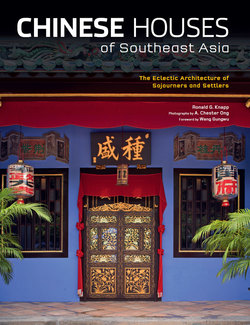Читать книгу Chinese Houses of Southeast Asia - Ronald G. Knapp - Страница 7
На сайте Литреса книга снята с продажи.
ОглавлениеA FEAST OF COLORS AND DESIGNS
I do not know when professional architects of Chinese descent first began to design residences in Southeast Asia, or when their work began to change the built environment away from what was indigenous or traditionally Chinese. The buildings described in this book predate the rise of their profession and reflect the times when sojourners were beginning to transform themselves into settlers and could still exercise their personal choices.
The illuminating text and beautiful photographs also bring back memories of the numerous homes in the region that I have lived in. The first home I remember was a standard public works residence built for junior civil servants in the Malay state of Perak, a state that the British claimed to “protect” on the Malay Peninsula. This was in Ipoh, the capital of Kinta, one of the richest tin mining valleys in the world and where many wealthy Chinese built their mansions. Unlike their fine homes, our small house was inspired mainly by Malay designs and was built on short stilts not more than four feet above the ground. The most striking feature was the covered corridor that connected it to the kitchen and servants’ quarters at the back of the house, some 20 yards away.
My family went on to live in houses built by the Chinese themselves. In Ipoh, the Chinese who moved up the social scale from unskilled mining and plantation laborers preferred to live in rows of shophouses beside the main streets. We had our share of living in several of these. Away from towns, there were those who followed Malay practice and built their houses on stilts. But, when they were ready to build their family homes, mostly on the edge of town, they turned to models of the traditional homes they admired in China. They also noted the work of European architects and adapted their newer homes to the need to appear fashionable.
We had the chance to live with one such upwardly mobile family and saw them transform a large Malay-type house into a new mansion. What struck me most was, the richer our host became, the more the Malay features about his house were replaced by things and shapes that were markedly Chinese or European. The overlap of Chinese ethnicity and Western modernity quickly edged out much of what was indigenous to the tropical environment.
Later, when I began to meet Southeast Asian Chinese trained in Britain and elsewhere in the West to be professional architects, I became conscious of how instinctively eclectic my host in Ipoh had been in the choices he made for his extended home. Whether in its external structure, the use of interior space, the adornments on the roof, the plan of the garden, or the selection of furniture for the public and private rooms, there was dissonance in the midst of elegance accompanied by several corners of splendid harmony. By that time, I realized that many other newly rich Chinese also displayed varying degrees of eccentric individuality that made their residences unforgettable.
Today, cautious public planners and venturesome private architects vie for the attention of new rich Chinese in every urban center. There is better appreciation of indigenous artistry, and the mixtures they offer are less whimsical and contrived. There is also brilliance surrounded by mediocrity. But overall the effect is one of confusion that the competing styles do little to minimize. It would appear that we need time to weed out the unmemorable so that, decades from now, the best of them that survive will be lovingly studied by someone like Ronald Knapp.
The houses described in this book represent some of the finest and best preserved or restored in Southeast Asia. I have visited most of those in Malaysia and Singapore and a few others in Jakarta, Semarang, Bangkok, and Manila. But Ronald Knapp has examined all of them closely. His sensitive and meticulous descriptions have opened my eyes to points of transmission and adaptation that I had missed. Altogether, the book provides a feast of colors and designs that appeals both to my interest in their histories and to my suppressed desire to have a family home of my own.
In particular, how he has described the mix of convention, sacral loyalty, and keeping up with the times captures the many layers of emotions that most sojourning Chinese experienced when they decided to settle down. By doing that, the author has opened new doors to all of us who are fascinated with the plurality of Southeast Asia. He has also enabled new generations of Chinese overseas to savor some of the delights in the lives of their transplanted ancestors.
Wang Gungwu
National University of Singapore
